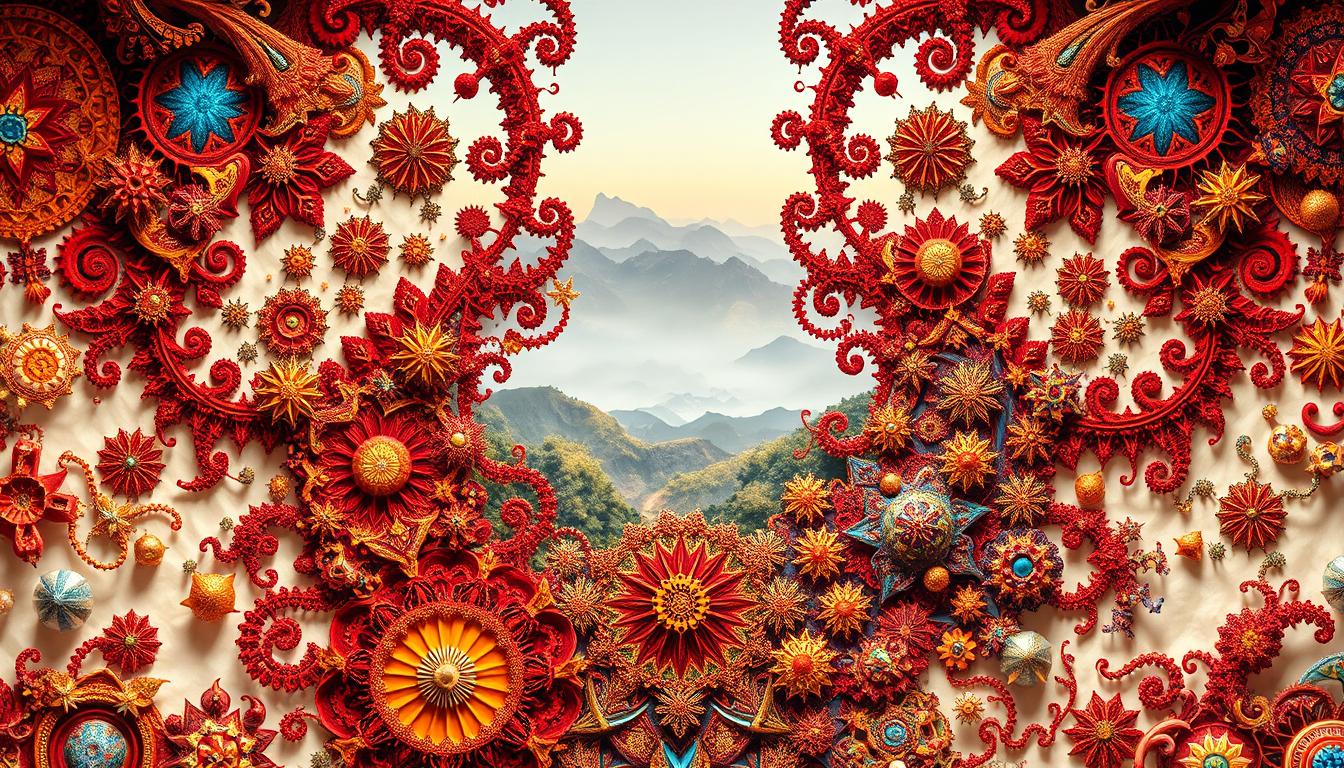Long ago, before modern math even started, ancient cultures knew a lot about fractals. Civilizations like the Egyptians, Greeks, and Mayans used patterns and shapes in their buildings, art, and how they saw the world. When we look at ethnomathematics, we discover the importance of these patterns. It shows how ancient people understood and showed nature’s complexities.
This journey into the past helps us see the impact of their knowledge. It affects not only our cultural views but also how we see fractal geometry today.
The Role of Patterns in Ancient Civilizations
Patterns were crucial in shaping ancient societies, affecting their buildings and cultural symbols. These civilizations used geometry and astronomy to make sense of the world. This resulted in constructions that were not just useful. They also carried deep spiritual meanings.
Geometry and Astronomy in Ancient Architecture
The Egyptians and Mayans are examples of societies that applied geometry to mirror the stars. The Pyramids of Egypt, for instance, line up perfectly with certain celestial objects. This shows they were placed thoughtfully within a cosmic setup. These grand designs show beauty and a deep cosmic understanding. They reveal where geometry meets astronomy.
Spiritual and Societal Principles Encoded in Design
The detailed designs of Mayan codices show cultural values and beliefs. These designs were more than just for looks. They offered deep insights into the cosmos, life, and society. By using these designs in their buildings, ancient societies showed their relationship with nature and their role in the world.

Decoding Ancient Mathematical and Design Principles
Ancient cultures knew a lot about math, especially the Golden Ratio and the Fibonacci Sequence. They used these ideas to make art and buildings beautiful. By studying old art and buildings, we can see how math and beauty are connected.
The Influence of the Golden Ratio and Fibonacci Sequence
The Golden Ratio is known for its beauty. It has influenced both architects and artists. For instance, the Parthenon uses this ratio to achieve perfect balance. The Fibonacci Sequence shows up in many types of ancient art, like sculptures and paintings. It reveals a planned approach to creating things that people still enjoy looking at today.
Geometric Symbolism in Art and Architecture
Geometric symbols are found in lots of old items, showing deep mathematical ideas. The Egyptian pyramids are a good example. They show how important geometric principles were for building. Simple shapes became meaningful symbols. They mixed the Golden Ratio and Fibonacci Sequence in ways that are still fascinating. This mix shows that people have always found geometric shapes beautiful. It gives us a window into how ancient people thought.
How did ancient cultures understand fractals
Fractal patterns were key in the art and architecture of old civilizations. They show an early grasp of patterns found in nature. Livia dos Santos Sousa’s work on Fractal Ethnogeometry shows this connection clearly.
Fractal Patterns in Ancient Structures and Artifacts
Ancient people often used fractal patterns in their creations. This shows they valued the geometry around them. They included:
- The geometric layouts of ancient temples
- Decorative motifs on pottery and textiles
- Architectural features that replicate natural forms
Fractal patterns meant more than just decoration. They reflected life’s cycles and the bond between humans and nature.
Connection to Nature and Cosmology in Ancient Cultures
Ancient beliefs were deeply tied to the cosmos, shaping their view of fractals. They aligned their buildings with the stars. This cosmos connection is visible in:
- The orientation of pyramids to line up with celestial events
- Symbolic designs of nature in sacred places
This blend of the cosmic and natural showed a unique worldview. Through their work, ancient people linked nature, the cosmos, and the divine together.
Fractal Geometry: From Ancient Insight to Modern Science
Fractal geometry’s story is a link between ancient wisdom and modern science. This math concept started with early civilizations. They noticed natural patterns and used them in design and architecture. Understanding these historical patterns shows their impact on today’s art, architecture, and ecology.
The Evolution of Fractal Geometry and Its Historical Context
Mathematicians began to notice complex patterns in nature, leading to fractal geometry. Georg Cantor and Benoit Mandelbrot played key roles. Ancient cultures also applied these ideas in their art and architecture. Fractal geometry’s evolution comes from studying complex designs and natural wonders, showing a deep appreciation for complexity.
Impact of Cultural Understanding on Present-Day Applications
Today’s use of fractal geometry builds on ancient practices. This includes architects and artists making beautiful designs. Scientists use it to understand ecological and geological systems. This shows how old ideas help improve our technology and innovation. The blend of art and science highlights fractal geometry’s role in modern times.
Architectural Examples of Fractal Patterns in Ancient Cultures
Looking at ancient architecture shows us a deep link between design, math, and the universe. The Kandariya Mahadeva Temple in India and the Mayan Pyramids stand out. They show the beauty of fractal patterns and their tie to the stars.
Kandariya Mahadeva Temple in India
The Kandariya Mahadeva Temple displays amazing carvings of fractal patterns. Its design shows self-similarity, meaning parts of it mirror others. This creates a pleasing visual effect.
The temple’s detailed sculptures and motifs are not just art. They show deep mathematical knowledge. The use of fractal geometry lets the temple fill both spiritual and visual roles. It shows the culture’s values back then.
Mayan Pyramids and Their Cosmic Alignments
The Mayan Pyramids are masterpieces of ancient engineering, lined up with the stars. Their stepped designs show a deep understanding of geometry and astronomy. This alignment with the heavens shows the Mayans’ deep knowledge of the universe.
These magnificent buildings show how architecture can reflect cultural and astronomical ideas. With these structures, the Mayans linked themselves to the cosmos. They also showed off their skill in using fractal patterns.
Patterns in Nature: A Shared Understanding
Nature’s patterns show the world’s beauty and complexity. We see natural fractals in ecosystems and landscapes. From fern leaves to coastlines, these patterns follow math principles. They show perfect harmony in nature’s designs.
Natural Fractals in Ecosystems and Landscapes
Ecosystems are full of natural fractals. Look at tree branches, river networks, and clouds. They all share similar patterns, no matter the size. Each one adapts to its environment but shows a common design. This helps distribute resources efficiently, aiding species survival.
Self-Similarity Across Different Cultures’ Interpretations
Cultures worldwide have seen these natural patterns in their art and stories. Indigenous tribes use these motifs in crafts, showing their bond with nature. Modern architects also use these patterns. They design buildings that fit beautifully into their environment. This shows a global love for nature’s intricate designs.
Modern Interpretations: From Ancient Lessons to Contemporary Designs
Today, architects often look back to ancient designs for inspiration. They blend old patterns with new ideas in their creations. This mix highlights how timeless concepts from the past find a place in today’s designs. Many projects showcase this blend, using cutting-edge technology.
Influence of Historical Patterns on Modern Architecture
Historic designs deeply influence today’s architecture. Key impacts include:
- Using fractal geometry to create buildings that are both appealing and strong.
- Incorporating spiral and symmetrical layouts from old structures, which bring beauty and balance.
- Choosing materials and methods that cherish tradition but also value new advancements in sustainability and efficiency.
Adapting Ancient Designs to Current Technologies
Modern technology helps bring ancient design concepts into today’s architecture. Some ways this is done:
- 3D modeling tools make it easy for architects to mimic complex shapes.
- New materials improve the lifespan of buildings and allow for innovative designs inspired by the past.
- Technologies in smart buildings boost energy savings and functionality, reflecting age-old architectural principles.
Cultural Perspectives on Fractals
Looking at fractals through ethnomathematics shows how cultures view math. Ethnomathematics brings cultural views into math, like fractals. It shows how societies use math in art, buildings, and everyday life.
Ethno-mathematics and Its Role in Understanding Fractals
Ethnomathematics points out how culture matters in math study. It says fractal concepts aren’t just Western but are global. This view lets us see how different cultures see fractals, in things like buildings or fabrics.
Diverse Interpretations Across Cultures and Their Values
Various cultures have different takes on fractals, showing many ways to see them. Indigenous groups might see fractals as nature’s patterns, relating them to spiritual beliefs and the environment. Meanwhile, modern societies might focus on fractals’ math and tech uses. This shows how culture enriches fractal studies.
Challenges and Limitations in Recognizing Fractal Patterns
Studying fractal patterns in old cultures is tough. One big issue is confirmation bias. This means researchers often see things through today’s ideas, not those from the past. Such wrong views can hide the real importance of fractals back then. They also make it hard to see what fractals truly meant.
Confirmation Bias: Misinterpretations in Ancient Contexts
Confirmation bias happens when scholars see what they expect, ignoring evidence that doesn’t fit. This can twist our view of how ancient people saw and used fractal patterns. Trying to match old artifacts to today’s patterns might miss better explanations. These could show how ancient people really thought.
Technological Limitations in Historical Analysis
Studying old artifacts faces tech hurdles. Many tools aren’t advanced enough to show the complex fractal details in ancient designs. Not having better imaging or computer models also makes things hard. So, researchers might not spot key fractal aspects. This could uncover more about how different cultures related to their worlds.
The Future of Fractal Discovery in Cultural Contexts
Exploring the future of fractal discovery shows us new ways to understand cultures through science. As researchers dig into how ancient fractal patterns work, using advanced AI technology opens up the door to new discoveries.
Implications for Modern Science and Cultural Understanding
Fractal research helps many fields like anthropology, art history, and environmental studies. By studying these patterns, scientists can:
- Find complex stories in art and buildings.
- Look into natural patterns that influenced old societies.
- Make new design and sustainability breakthroughs by studying ecosystems.
The Role of AI in Uncovering Historical Patterns
AI is key in better understanding fractals within cultural settings. This tech helps to:
- Look through lots of historical data for fractal patterns.
- Run simulations to see how cultures developed their unique styles.
- Boost working together among different researchers, encouraging teamwork in discovery.
Conclusion
Studying how ancient cultures understood fractals reveals a deep wisdom passed down through ages. These societies saw complex patterns in everything around them. They used these patterns in their buildings, art, and religious practices. This shows they knew fractals were more than just pretty designs. They connected them to the world and their beliefs.
This discovery sheds light on the fact that ancient knowledge still impacts us today. Modern science, buildings, and art take cues from these old ideas. It proves that the beauty of fractal patterns is timeless. They bridge the old with the new, showing how past wisdom fuels today’s innovations.
In the end, learning about fractals in ancient times deepens our understanding of history and now. It makes us think about how we can use old insights for new projects. Merging tradition and modernity leads to creative and lasting designs. Fractals show the ongoing curiosity we all share. They represent our quest to understand more.



